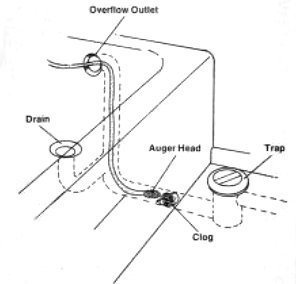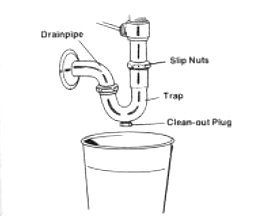Sluggish or completely stopped, clogged drains are no fun but you don’t necessarily need a plumber to fix them.
Slow-Running Drains
It’s best to deal with slow-running drains before they quit entirely.
Use a commercial chemical drain cleaner to improve drainage, follow the manufacturer’s instructions exactly.
Caution: Most chemical drain cleaners are caustics.
Handle them carefully, wear rubber gloves, and wash your hands and the gloves at another sink after using a chemical drain cleaner.
Completely Clogged Drains
Don’t Use a Chemical Cleaner
When a drain clogs completely, don’t use a chemical drain cleaner. If it doesn’t work, caustics trapped in the pipes can be dangerous.
The Plunger Method
In most cases a rubber plunger can effectively remove the clog.
Use a plunger with a head big enough to cover the blocked drain opening completely.
Preparing the Drain for the Plunger
Remove the strainer or stopper from the drain and add enough water to the sink or tub to cover the head of the plunger.
If the sink or tub is full, scoop out excess water so that only the head of the plunger will be covered.
Block Overflow outlets completely with wet rags.
If any other drain is connected to the same line as the blocked drain (in a double kitchen sink, for instance, or where two laundry tubs drain into one pipe) block the connected drain completely with wet rags.
Applying the Plunger
Coat the bottom edge of the plunger’s cup generously with petroleum jelly, and set the plunger in the sink or tub, sliding it into place to cover the blocked drain completely.
Pump the plunger quickly up and down 10 or 12 times, pushing firmly to build up a strong pressure. Then jerk the plunger quickly away from the drain.
If the clog has been removed, the water will drain out of the sink or tub.
If nothing happens, repeat the plunging procedure. Plunge at least twice more before resorting to more drastic means.
The Drain-and-Tap Auger (Plumbers’ Snake)
If repeated plunging doesn’t remove a clog, use a drain-and-trap auger (otherwise known as a plumbers’ snake )to break up the obstruction.
Dip any water out of the sink or tub and remove the strainer or stopper from the drain.
Using the Drain-and-Tap Auger in the Drain
Insert the end of the auger into the drain.
To feed the auger wire in tighten the thumbscrew that locks the wire in place.
Turn the handle of the auger clockwise on the wire and push to force the wire into the drain, then loosen the thumbscrew and slide the auger handle back up the wire.
Repeat the procedure, tightening the thumbscrew turning the handle clockwise, and pushing to work the auger into the pipe.
Work the auger steadily into the pipe.
Hitting a Hard Obstruction
If you hit a hard obstruction, the wire is probably hitting a bend in the pipe, move the auger handle right up to the drain opening and tighten the thumbscrew.
Work the auger slowly into the pipe, twisting the handle to twist the wire inside the pipe until the wire slides around the bend.
Hitting a Soft Obstruction
If you hit a soft obstruction, the wire has probably reached the clog in the drainpipe.
Work the auger slowly into the obstruction, twisting the handle to twist the wire against the clog in the pipe.
Work at the clog until you feel it break up.
Then twist the auger a few more times and pull the wire back turning the handle counterclockwise to reel the wire in.
Finishing Up with the Auger
Remove the auger from the drain
Flush the drain with a bucket of very hot water mixed with liquid detergent or strong household detergent.
Using the Auger in the Overflow Outlet

If you can’t remove an obstruction in a bathtub drain by using an auger inserted into the drain, remove the screws securing the overflow plate above the drain, and take the plate off.
Insert the auger into the overflow outlet and work it down through the overflow pipe and into the drainpipe.
Flush with very hot, soapy water poured down the drain.
Inserting the Auger into the Clean-Out Opening
If you can’t remove an obstruction in a sink drain by using an auger inserted into the drain, tackle the clog through the U-shaped trap under the sink.

Set a bucket under the trap.
If there’s a clean-out plug at the low point of the trap, remove the plug with pliers or an adjustable wrench.
The water in the sink and the trap will run into the bucket.
Insert the auger into the clean-out opening.
First up the branch of the trap toward the sink and then up the other branch toward the drainpipe.
If you don’t hit an obstruction in the trap, work the auger as far as you can into the drainpipe.
In most cases you’ll be able to clear the pipe.
Pull the auger wire back and remove the auger, coat the threads of the clean-out plug with petroleum jelly and replace the plug,
Flush the trap and drainpipe with very hot. soapy water.
Checking the Trap
If the sink trap doesn’t have a clean-out plug remove the entire trap.
Set a bucket under the trap.
Holding the trap with one hand, unscrew the slip nuts at each end of the trap section, using an adjustable wrench.
Slide the nuts out of the way on the connecting pipes and carefully lift the trap out empty it into the bucket.
Check the trap for obstructions and clear it, if necessary, with the auger. Then scrub it clean with hot, soapy water and a small stiff brush.
Insert the Auger into the Drainpipe with the Trap Removed
If the obstruction isn’t in the trap, insert the auger into the drainpipe and work it into the pipe as far as you can.
If you hit an obstruction, feed and twist the auger to break it up.
Then pull the auger wire in remove the auger from the drainpipe.
Replacing the Trap
Finally, replace the trap.
Coat the threads of the trap and the pipes with petroleum jelly and reposition the trap.
Be careful to replace washers and slip nuts exactly as they were before.
Tighten the slip nuts that hold the trap in place.
If the obstruction was in the drainpipe, flush the pipe with very hot, soapy water.
If the Drain is Still Clogged…
If you can’t eliminate a sink clog at the trap. the obstruction may be in the main drainpipe, and may even be outside the house.
Call a plumber to eliminate the clog
